You might have done the SWOT analysis of many organizations like PepsiCo, Amazon, Walmart, Apple computers etc. In this article, I am going to discuss with you “how to do a personal SWOT analysis.
SWOT analysis is necessary for your successful life. When you think of a successful life, at that point, determination and talent are the two things that will help you in getting success.
When you think about the strengths, you will also find some of the weaknesses. To overcome your weakness, you will definitely think to manage those, so that it will not hinder your path of success.
These strengths and weaknesses also apply to organizations, that want to become successful in their respective fields. But in this article, I will focus only on personal SWOT analysis.
The question that arises here is, “How you will recognize the weaknesses and strengths?” and also, “How will you investigate the threats and opportunities for them?” You will find the answers to the above two questions in this article composed by experts at All Assignment Help
What is personal SWOT analysis and why it is important?
Before starting a discussion on personal SWOT analysis, you need to understand the need for personal analysis.
Personal analysis is a time period, where you realize weather you need preparation or training. This is aimed at recognizing yourself as a college student or in an organization and whether you are able to meet your objectives or not. A personal analysis recognizes you whether you are not meeting desired performing goals or requirements.
A personal analysis simply means everything you want to know about yourself. And this is very important for you to get success. Because of personal analysis, you know where you are lagging behind. You also get to know where you can improve yourself. You will now be fond of your aim and vision of your life. And also, you know, where you should get yourself in to excel in your career.
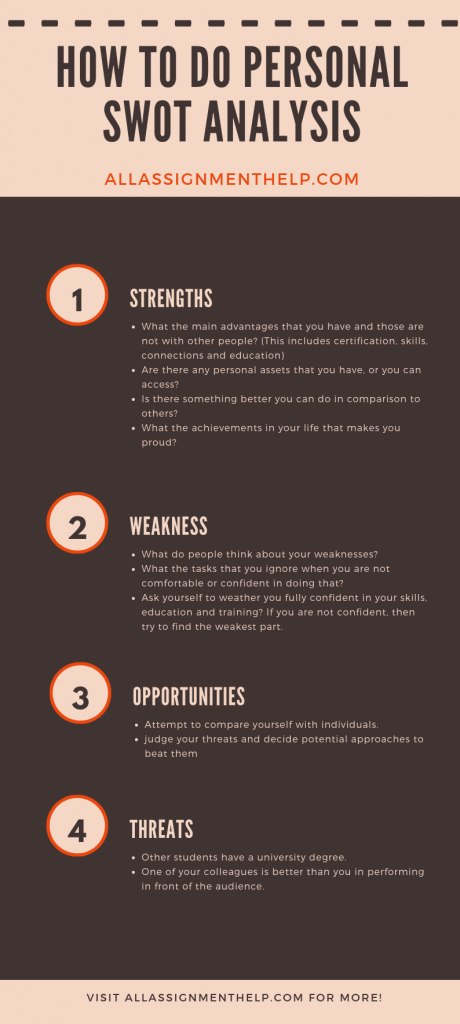
Personal SWOT Analysis
SWOT analysis is a powerful process used by organization to evaluate themselves and their competitors. But, this technique is now limited to organizations only.
This can be useful for the one who is searching for a job and those wishing to climb the ladder of success and when SWOT is used to analyze yourself, it is known as a personal SWOT analysis. Before doing personal SWOT analysis, you must be aware of your career goals and aspiration, after that, you will find is an analysis of your internal and external condition.
To analyse your internal and external condition, SWOT Analysis for personal development is useful.
Read More: Help with Marketing Components – A Brief Introduction
What should a personal SWOT analysis include?
A personal Swot analysis includes:
S = Internal Strength
W= Internal Weakness
O = External Opportunities
T = External Threats
Self swot analysis is a process which gets the data about your internal Weaknesses and Strengths and external threats and opportunities. The main way of doing your SWOT analysis is to consider your career as a business. And, treating yourself as a product which is a competitor.
First, analyze yourself utilizing the SWOT process. After analyzing yourself, you can start comparing yourself with friends. You will have the capacity which is required you to propel your career. This will help you accomplish your own objectives and can further improve your capabilities.

What is the motivation and purpose of a personal SWOT analysis?
Motivation
The motivation behind personal SWOT analysis is to identify the task that you can take to meet the necessities of the job or career. Contrasting your strengths and weaknesses with job necessities will recognize holes and help you become the best for the position you are aiming for.
When I apply this on myself then, I find that, all through my career, I have utilized this SWOT analysis every time while giving an interview for a new position. Using this activity encourages me to guarantee that I am prepared for the meeting for my new job or career.
SWOT helps me realize whether I am prepared to address the difficult questions from the questioners (for example, “Explain your greatest weakness”). This process enables me to monitor areas that may be potential issues during the meeting.
If you need a good career ahead in your life, whether it is a job or getting admission in a good university, you need to follow SWOT. As a result, you will get to know about your Weakness, so that you can convert them into Strengths. You can identify the opportunities for growth so that you can overcome threats.
Purpose
Before I, start explaining to you the purpose of personal SWOT, first look at this infographic. In this infographics, you will get to know the benefits of personal SWOT.
The main purpose of a personal SWOT analysis to analyze your objectives and skills. A personal SWOT analysis is the same as the SWOT analysis of the business. In a business SWOT analysis, you focus on the business environment and in personal SWOT analysis, you focus on yourself and your objectives.
Our page on SWOT analysis expresses that one of the major aims of SWOT analysis is to find whether the situation or conditions you can adopt or not. So, you can utilize it in a variety of circumstances.
A self SWOT analysis can also be more valuable in the event that you focus on a particular objective or issues that you need to address. As you know, it’s not possible to overcome with each and every issue, this is the reason that
Skills and qualities that can assist you with one objective that might be not important or in the same way it can be a weakness in another specific situation. One threat in one circumstance might be an opportunity in another. You will need to perform personal swot analysis test on yourself to figure out your skills and qualities.
Here the main question that you face is, “how to deal with the tools of SWOT analysis?” To get the answer to this question, you will have to understand SWOT. So now, you will understand the process of SWOT in the next paragraph.
Read More: Assignment Writing Tips from Experts – Ideal Ways to Write Your Assignment
Process of SWOT analysis
So before explaining you SWOT Analysis, I will first like you to go through this Infographic. In this infographics, you will find examples of Strength, Weaknesses, Opportunities and Threats.
Now after going through the above infographics, you have the knowledge about SWOT. You know about self, about your SWOT. Now, let’s start explaining this.
Strengths
Before you analyze your strength, you need to question your self a few things:
- What the main advantages that you have and those are not with other people? (This includes certification, skills, connections and education)
- Are there any personal assets that you have, or you can access?
- Is there something better you can do in comparison to others?
- What the achievements in your life that makes you proud?
- Any specific value you believe in and in which other fails?
- What the various network that you are a part of and others are not?
To enable you to understand your strengths, envision yourself as a competitive item in the market. Individual strength is a resource for you as an item. This can be utilized as an approach to separate yourself from others when attempting to achieve or pursue your meeting. Let’s figure out some of the examples of personal swot analysis that student needs to know.
Examples of strengths:
- Ability to improve
- Strong project management skills
- Training and experience and in presenting to large audiences
- Recognized positive sales potential
Weakness
Before you analyze your weakness, you will again ask yourself questions like:
- What do people think about your weaknesses?
- What the tasks that you ignore when you are not comfortable or confident in doing that?
- Ask yourself to weather you fully confident in your skills, education and training? If you are not confident, then try to find the weakest part.
- Ask yourself about the negative habits you have?
Personal weakness is a responsibility, or you can it is are where you can develop your strengths. These are highlights that can increase the opportunity for your future career or employment. You will understand this part with a personal swot analysis example that student needs to know.
Some of the examples of Weakness are:
- Tend to defer
- Feeling uncomfortable in speaking in front of groups
- Disorganized
- You are a poor listener
Opportunities & Threats
When you are considering your opportunities and threats, I generally think that it will be easy, to begin with, “threats”.
Attempt to compare yourself with individuals with whom you can compete for that next promotion or job or getting entrance in any university. At that point, as much as possible, judge your threats and decide potential approaches to beat them.
Some of the examples of Opportunities are:
Threats: Other students have a university degree.
Opportunity: You can join a night class and complete your graduation.
Threat: One of your colleagues is better than you in performing in front of an audience.
Opportunity: You should join personality development classes and become a master at presenting yourself in front of the audience. You can also seek clarification from an assignment helper online if you are seeking more clarification for the swot analysis topic
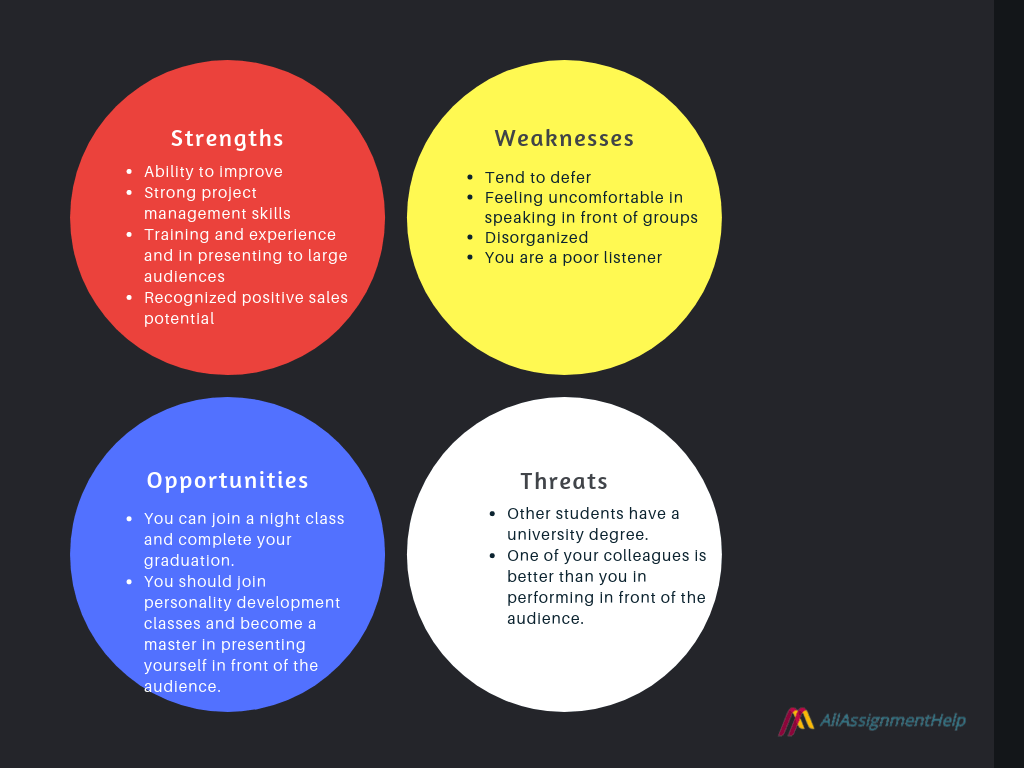
Examples of Personal SWOT Analysis
In this section, I will discuss you with some of the examples or cases of Personal SWOT analysis that is based on the career or job.
Example 1: Personal SWOT analysis of a Data Scientist
Do you that Data science has turned into a revolutionary innovation that everybody discusses. It has emerged as one of the ‘hottest job’ of the 21st century.
Data science is a field where few people know about innovation in its actual sense. While many seek to move toward becoming data scientists, it is important to gauge the strengths and weakness of data science and give a practical picture. In this section, we will examine these points in detail and give you important knowledge about data science and data scientist, with the help of SWOT.
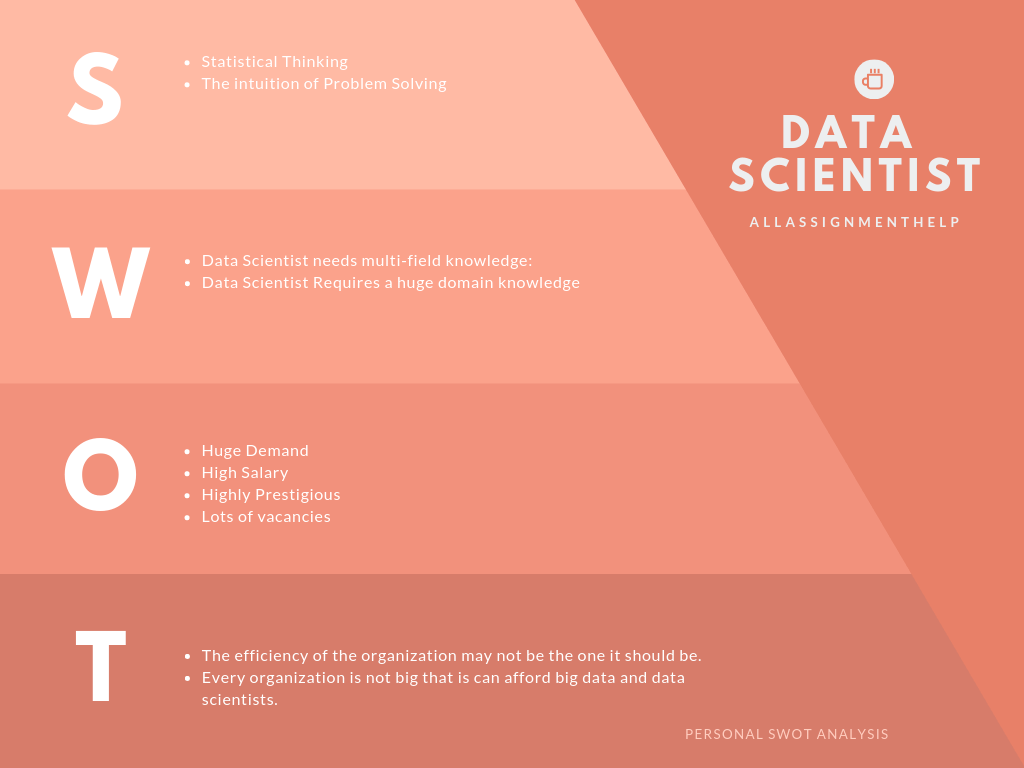
Strengths and Weakness
The field of data science is huge in scale and data scientist has its strength and weakness. Hence, here we will measure the upsides and downsides of data science.
Strengths
- Statistical Thinking: When you are working in data science, applied arithmetic and statistics can frequently be obscured by the way that you are simply writing code or utilizing a function. The better you understand that hidden procedure, the better you will utilize it.
- The intuition of Problem Solving: This is one of the major strength of a data scientist.
Companies are simply beginning to incorporate Big Data into their procedures and understand the advantages. The researcher found that utilizing Big Data and its analytics will make the possibility for a business to perform thier best.
Weakness
- Data Scientist needs multi-field knowledge: Being a combination of numerous fields, data science originates from statistics, software engineering and arithmetic. It is possible to ace in each field and to practice similarly in every one of them. An individual with knowledge of statistics will be unable to master software engineering at short notice to turn into a talented data scientist. In this way, it is a continuously changing, dynamic field for which you must keep on learning different strategies for data science.
- Data Scientist Requires a huge domain knowledge: This is one more weakness of data science which is reliance on domain information. An individual with extensive knowledge in statistics and software engineering will think that it’s hard to tackle the data science issue without his experience and knowledge.
Opportunities
- Huge Demand: In the 21st century, with the increase in digital business, there is a huge increase in the demand of Data Scientists. Prospective seekers of jobs have numerous opportunity. It is the fastest developing job on Linkedin and is anticipated to make 11.5 million occupations by 2026. This makes data scientist a highly paid job.
- Lots of vacancies: As you know, becoming a Data Scientist is not as simple as drinking a cup of coffee. Very few people have required skillsets of becoming a data scientist. This is where you will find that there is very less data scientist as compared to other professionals in the Information Technology field. You can say that demand is very high as compare to availability.
- High Salary: You will be surprised to know that according to the latest statistics, Data Scientist is one of the most highly paid jobs. As per Glassdoor, the salary of a data scientist is 117000 UDS on an average. This makes data science a very attractive career option.
- Highly Prestigious: This is one of the opportunities that data scientist have. Data scientists enable organizations to make a better decision for thier business. Organizations depend on data scientists and utilize their aptitude to give better outcomes to their clients. This gives data scientists a significant position in the organization.
Threats
- The efficiency of the organization may not be the one it should be.
- Every organization is not big that is can afford big data and data scientists.
Example 2: Personal SWOT Analysis of a Teacher
This analysis can be very gainful for teachers, as well as for the students like you as SWOT gives fundamental data to individuals/students or businesses who need a vision for their future or find an issue. So let’s start with Strenght.
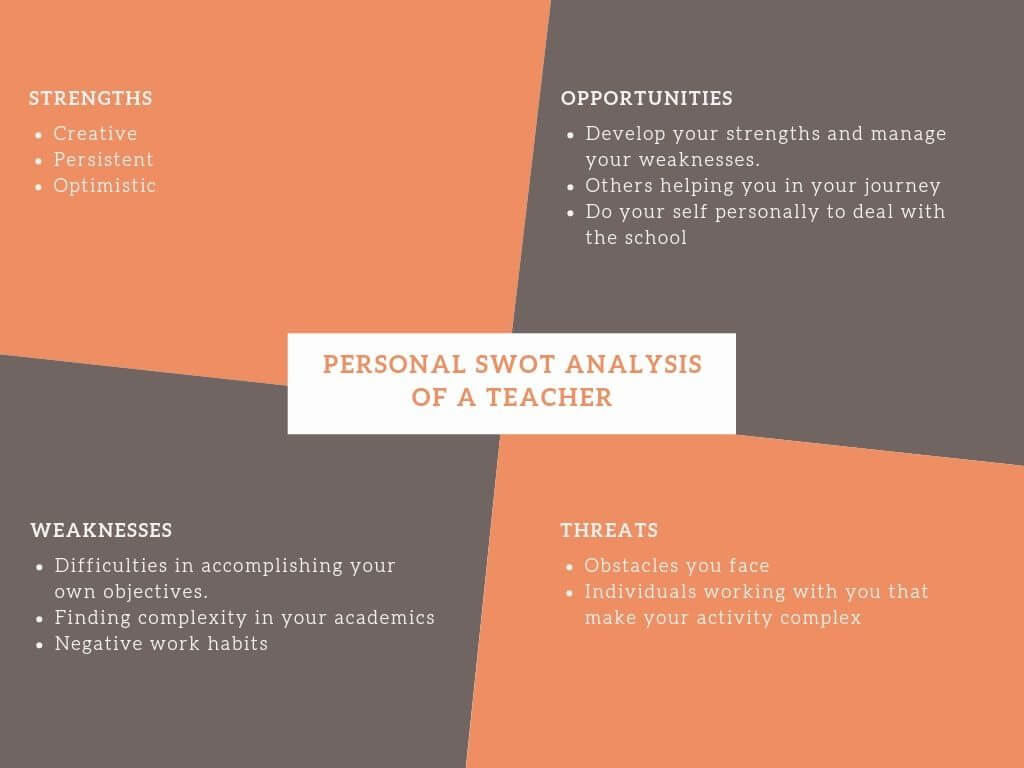
Strengths
SWOT is a tool for measuring strength and to recognize internal and external strengths of people, children or teachers, and to look for input, plan specific questionnaires, keep up account records, do group exercises at inter and intra levels. As a teacher, you need to ask your self the following questions:
- Which accomplishments would you say you are most proud of this year?
- You will ask yourself, What topics or subjects would you say you were good at?
- What did your learning approach work for you?
- What are you pleased with accomplishing?
- You will ask yourself, What new abilities did you create?
- What individual resource would you be able to get to?
- What values do you exceed expectations in which others neglect to demonstrate?
Creative: After, getting answers to the above question, you as a teacher will be able to know whether you are creative or not.
Persistent: You as a teacher will get to know persistent and able to finish the given task which was started.
Optimistic: This is a major part of your strength. You will get to know whether you are optimistic and you always see the bright side of everything.
Weakness
There’s a quote “‘The greatest weakness of all is the great fear of appearing weak” by Jacques-Bénigne Bossuet. So often in your career, numerous issues identified with self-awareness grab hold of you and you don’t defeat them.
For example, a teacher in school may personally experience, the ill effects of low confidence and a similar weakness may occur at his students and vice versa.
To know your weakness, you will need to ask yourself the following questions:
- What were your biggest difficulties in accomplishing your own objectives in school?
- What did you find complex in your academics/vacation this year?
- Is it accurate to say that you are completely sure about your degree of learning level and skill training?
- What are your negative work habits and traits?
- Which abilities do you have to work on at additional level?
- What are the areas of your vision did you battle with?
- You didn’t feel certain about your capacity to succeed?
Individual internal or external observations must be understood in a genuine and reasonable manner. You must always accept that there are weaknesses, be sure about them, request guidance from others, evaluate yourself normally, ignore the past and put forward your best effort next time.
Opportunities
Everyone gets an opportunity, either once or more than once in thier life, but not every individual uses them wisely and climb a ladder of success.
To know your opportunity, you need to ask yourself the following questions:
- What would you do to develop your strengths and manage your weaknesses?
- Who you meet this year who may have the option to help you in your journey?
- You will ask yourself, what will be distinctive about one year from now that will create opportunities for change?
- What can you do your self personally to deal with the school one year from now?
- What can change the one thing that has the biggest effect on you being a progressively powerful learner/teacher?
As a teacher, you must figure out how to grasp new opportunities and take them to the students.
Threats
Under Swot analysis as a teacher, you must learn to avoid real problems when you try to meet something. As a teacher, you must ask yourself these questions and find out the reasons for our shortcomings.
- What are the biggest obstacles you face in making changes in your learning/career?
- Are there other individuals working with you that make your activity complex?
- You will ask yourself, what keeps you away from accomplishing what you are able to do?
- What difficulties do you face in being motivated to do your schoolwork?
- What difficulties do you face in managing procrastination and distracting?
if you find yourself struggling while writing essays, articles or assignments you can get an online assignment writing service that will help you write a detailed piece of content properly.
Example 3: Personal SWOT Analysis of Human Resource Manager
In this section, Assignment Writing Service will tell about the personal SWOT analysis of an HR Manager.
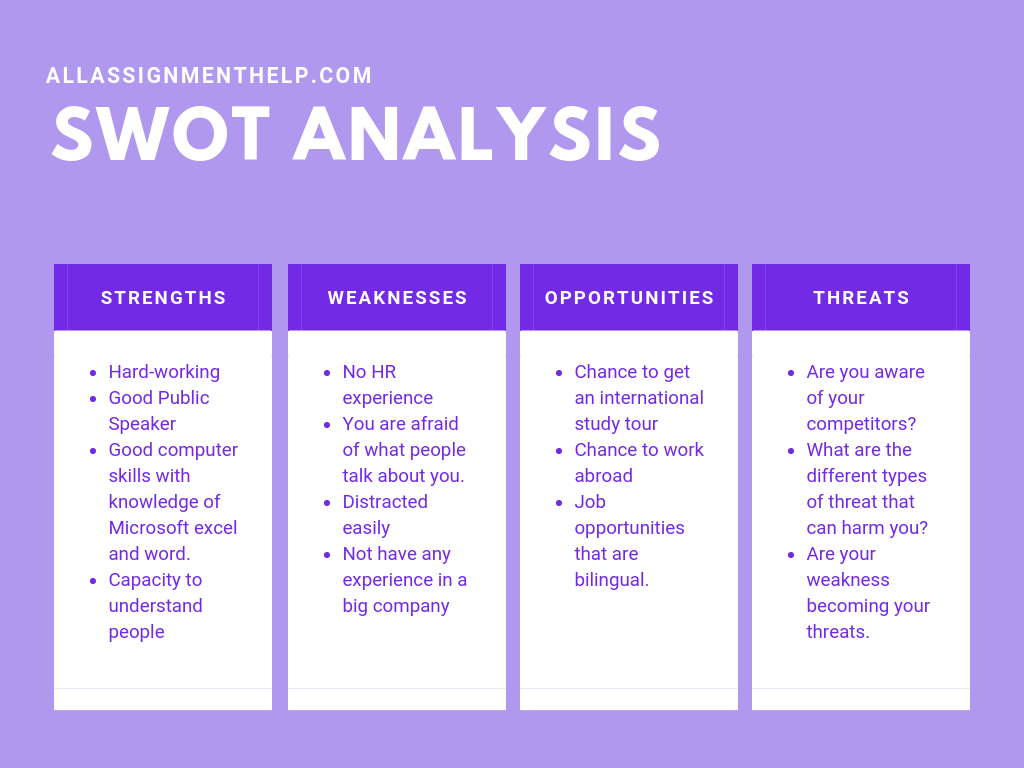
Strength
HR is an important part of every company. With the different leadership strengths, HR is known for compliance, employee development and advocating for the individual workers and organization.
- What are the things you considerably do well?
- What remarkable asset would you be able to draw on?
- You must ask yourself what do others see as your strength?
Here are the qualities of the HR manager:
- Hard-working
- Good Public Speaker
- Good computer skills with knowledge of Microsoft excel and word.
- Capacity to understand people.
- On-Time
- Reliable
- Multi-Tasker
- Quick Learner
- Speaks fluently
The HR expert represents considerable authority in everything from employment law to compensation and benefit. Employees move to guarantee the association meets the rules.
Weakness
HR has gained a reputation for being a little slow to adopt new processes and, in turn, is slow to complete tasks.
As HR and individuals the management of people become considerably core to the accomplishment of an organization, they need to take a look at their different obligations through a vital focal point. Here you will ask yourself a few questions as an HR:
- What are things that you can improve?
- You will ask yourself what resources you have that others don’t?
- What are the chances of seeing others as weaknesses?
After asking yourself the above question, you will get to know the following weaknesses:
- No HR experience
- You are afraid of what people talk about you.
- Distracted easily
- Not have any experience in a big company
- Procrastinate
- Impatient
- Emotional
- Managerial time is limited
Opportunities
To know the open opportunities for yourself, you as an HR will have to ask a few questions:
- What patterns would you be able to exploit?
- What opportunities are open for you?
- How might you transform your strength into opportunities?
Here are the opportunities that HR managers get:
- Chance to get an international study tour
- Chance to work abroad
- Bilingual job opportunities.
Threats
There are a lot of external factors that can act negatively on the organization as well as the department of HR.
An example of an external threat can be a competitor who had the option to poach your beast sales-man. Now you need to fill the position the employee left, and also, need to build up a strategy to keep up your success of the organization without her, in spite of the likelihood that he/she is utilizing those practices in his/her new position.
You need to ask yourself the following question to know about the threats:
- Are you aware of your competitors?
- What are the different types of threats that can harm you?
- Are your weakness becoming your threats
Example 4: Personal SWOT Analysis of Sales Manager
At the point when I chat with sales managers, potential customers, and potential clients, this is normally that they search for approaches to create more income; Control sales costs or enter new markets.
Strength
As a sales manager, you will ask about the best places for yourself when you want to develop a new sales strategy. You need to take advantage of the great you do and develop on it. So let’s discuss the question that will tell about your strengths.
- What are things that makes your sales team better than any other in the market?
- Do your present clients see as a profit by working with your sales team?
- What qualities does your present product line offer that your rivals can’t?
- Do you have exceptional sales processes, services, or products that makes you unique?
Weaknesses
Each sales team has weaknesses and as a sales manager, you have to recognize them rapidly and make a move. The issue comes when sales managers anticipate that they should improve or weaknesses will inexplicably disappear.
- Do you consider rivalries to be your greatest weakness?
- What do your present clients see as a weakness in your sales style, services, or product?
- When you take a look at your lost sales report, for what reason were those prospects not purchased from you?
- What are the things that you avoid?
Opportunities
Opportunity is generally around us, all you need is to identify them and take advantage of it at the right time. This can come when a competitor is not able to stand, innovation shows up, an opportunistic new manager enters your business, or change in law influences your clients.
Let’s now identify the questions to know your strengths:
- What are things that you see as a decent opportunity that will give a boost to your business?
- In which portion of your market are clients constantly shopping?
- Which high-margin services or products you can introduce in a broader market?
- Have you seen a change that can be exploited in your business or target market?
- Are their any markets for you to enter with more profit margins?
Threats
Threats are also an external factor just like opportunity and this can have a major effect on your business. To identify threats, we will ask some of the following questions:
- Does 25% of your sales income originate from under 10% of your client base?
- How would you balance the difficulties faced by your sales individuals?
- Is there any rival that continuously beats you in the market?
- What is the sum of the total bad debts on you?
- What are the desires for a sales meeting?
We hope you find this article helpful in meeting your academic requirements to run a personal swot analysis. We have a wide range of services where you can feel free to ask us to do your assignment.
Frequently Asked Questions
Q: What is a personal SWOT analysis?
A: A personal SWOT analysis is a self-assessment tool used to identify your strengths, weaknesses, opportunities, and threats in various aspects of your life, such as career, education, or personal development.
Q: Why is a personal SWOT analysis important?
A: It helps you gain a clearer understanding of yourself by highlighting what you excel at, areas needing improvement, potential avenues for growth, and possible obstacles to watch out for.
Q: How do I conduct a personal SWOT analysis?
A: Start by listing your strengths and weaknesses—internal factors. Then, identify opportunities and threats—external factors—by assessing the environment around you.
Q: Can I use a personal SWOT analysis for career development?
A: Absolutely! It’s a great tool for career planning. Recognizing your strengths and weaknesses can guide career choices, and spotting opportunities and threats can help navigate your career path.
Q: What are some examples of strengths and weaknesses in a personal SWOT analysis?
A: Strengths might include skills, traits (like adaptability or leadership), or resources you possess. Weaknesses could be lack of certain skills, fear of public speaking, or limited experience in a specific area.
Q: Can a personal SWOT analysis be done for non-career purposes?
A: Absolutely! It can be applied to education, personal relationships, entrepreneurship, or any area where self-assessment and goal-setting are valuable.
Q: What do I do after completing a personal SWOT analysis? A: Use the insights gained to create strategies. Leverage strengths, work on weaknesses, seize opportunities, and mitigate threats. Set SMART (Specific, Measurable, Achievable, Relevant, Time-bound) goals based on your analysis.
Q: Can a personal SWOT analysis be done with others’ input?
A: Yes, involving mentors, friends, or colleagues can provide additional perspectives and insights that you might not have considered.
